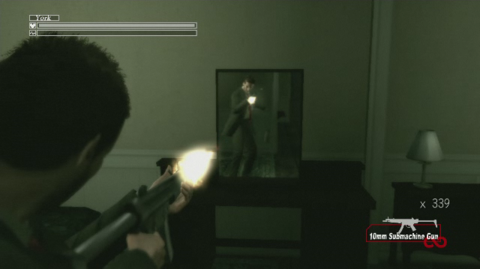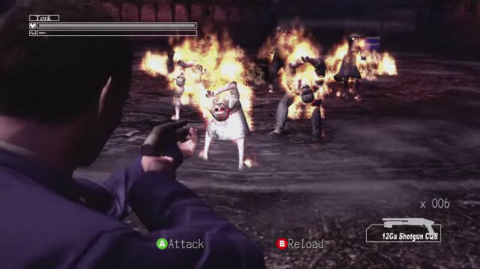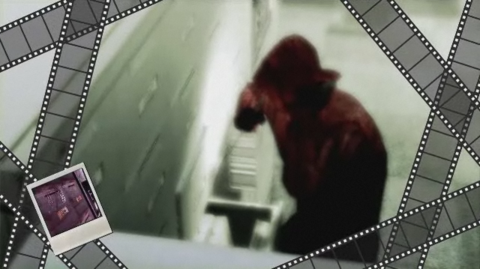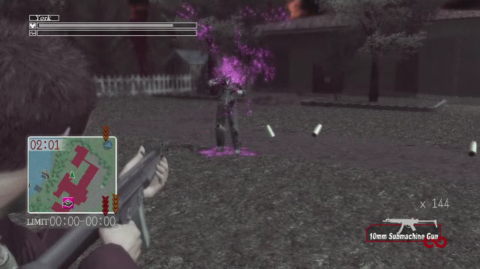Talkin' About Deadly Premonition - Part Two: Combat
By WickedCestus 11 Comments
This is part two in my attempt to write the most extensive in-depth look at Deadly Premonition that has ever or will ever exist. This ???(I'm thinking about ten?)-part series will explore every aspect of the game I can think of, and hopefully document every thought I have had about this video game over the past four years. (Part One is here)It is recommended that you have a very basic knowledge of the game first, as I am in far too deep to try to explain basic facts about the game. It's rambly, it's thought-provoking, it's silly, at times it's downright nonsensical: it's me talkin' about Deadly Premonition.

Deadly Premonition is a game that would probably have been better without combat. It's hard for me to say something like that about my favourite game, but it's true. The combat in this game had a few interesting ideas, but was generally a mundane, simple mechanic used to extend the game's length and give the player a bit more to do while investigating crime scenes. This part will be more tongue-in-cheek than Part One, because as a whole, I don't think the combat in Deadly Premonition is good.
I once said to myself that Deadly Premonition's combat would be perfect for H.E.A.T.: The Video Game, if it were to exist. Now, I've only seen H.E.A.T. once, and I don't remember a whole lot of it, but from what I do remember there is a lot of bullets being shot, and very few people getting hit with bullets. I first noticed this connection while standing in the hotel lobby, (a common place to find yourself near the beginning or end of a Deadly Premonition session) firing SMG bullets around the room whimsically. In Deadly Premonition, unlike other shooting video games, there is no reticle on the screen for where you are going to shoot. Guns have a laser sight, but it doesn't actually shop up on objects in the world, so you generally have no idea where you are shooting. The only time the game gives feedback to where you are aiming is when you have your laser on an enemy. This means that you have almost no idea where you are aiming unless you have already aimed at the place where you want to aim. This is incredibly silly. In terms of playing a shooting video game, it makes it hard to do. In terms of making you feel like Val Kilmer, it does a pretty good job.

This does not mean that the combat in Deadly Premonition is very difficult. Despite your character having restricted movement while aiming, and the aforementioned reticle ridiculousness, the combat is pretty simple. You sprint away from enemies, turn around, and then shoot bullets at them until they die. There are three enemy types in the game: Melee guys, Shoot-y guys, and weird wall-crawling Ring ladies. The ring-ladies we will get to later; for now, we will focus on the other enemies, which make up 80-90% of the combat scenarios in the game. The enemies have basically no AI to speak of; they just run at you with their weapons, or stand in one spot and try to shoot you. The most dynamic aspect of the combat is when sometimes there are exploding barrels. The dynamic here is that you shoot the barrels and they explode. Then everybody dies. It's pretty exciting.
The way the enemies get more difficult throughout the game is that they take more bullets to kill. That is the only way. Deadly Premonition takes bullet-sponges to an entirely new level. The average enemy about 3/4 through a playthrough on "Normal" difficulty takes approx. 30 shots to the head from an SMG. I'm no scientist, but I'm not actually sure that many bullets can fit into a human head. This may seem like a poor experience, and in some ways it is, but there are two key features that make even the most mundane enemy encounter in Deadly Premonition interesting. The first is that when enemies are hit with headshots it puts them into a stumble-backwards animation. This animation has zero priority, meaning that when you get many headshots in quick succession, such as from a rapid-fire SMG, the animation just repeats the first ten-or-so frames over and over in a loop of head-cocking, neck-snapping action. The second great feature is that whenever a headshot is landed, Francis York Morgan, the player character, utters an exclamation. These, too, have no priority, so when you are landing multiple headshots quickly, you will get a monologue that goes as follows: "Great, great, amazing, headshot, amazing, great, great, headshot, amazing, amazing, headshot, great." These two factors lead to hours upon hours of entertainment.
About halfway through the game, you start encountering a new enemy. At first, this leads to a rush of excitement; finally, the monotony of shooting the same dudes forever is over. Soon, this turns to feelings of resentment, as this new enemy is actually 110x more tedious than anything you have yet experienced. This enemy, of course, is the notorious Wall-Crawling Ring Lady. The Wall-Crawling Ring Lady, as the name suggests, crawls on walls (and the ceiling). She also has long hair like the Ring Lady. When you approach an area with a WCRL, walls are constructed ahead and behind you, limiting your combat area. WCRLs only show up in hallways; they also show up in every hallway. Whenever you walk into a hallway with no boxes in it, you know a WCRL is about to show up. It is the worst feeling; they are the worst. WCRLs are not hard. There is a very simple pattern to beating them; it is just time-consuming and soul-crushing. There are two weapons that make the fights bearable. If you have these two weapons, the fights will be tolerable. If you did not have these weapons and beat the game, I am honestly very impressed by your dedication. If you did not have these weapons and did not beat the game, I understand. It's okay. You didn't know. How were you to know that Keith Ingram's guitar is the key to beating the WCRLs?Yes, that's right; his guitar. It takes two hits to defeat them, while most other weapons take at least ten. The other weapon, a clear second best, is the flame-thrower. While it pales in comparison to the guitar, it is at least better than most things. (The grass-cutter is also pretty good, if I recall correctly.)
Of course, it is very possible that you can make it through the game and never find the guitar, the flamethrower, the grass-cutter, the laser sword, the RPG, the chainsaw, the infinite wrench, or even the infinite-ammo versions of the four core weapons. In fact, I'd say this is the largest detractor in the entire game. The best, most time-saving, and frankly, the most interesting and fun weapons in the game are hidden in side-quests, many of which aren't available until a significant amount of time into the game. If you aren't exploring and doing side-quests as you go, the combat quickly becomes unbearable, especially when the enemies suck up finite amounts of ammo very quickly. I generally don't like to advise people too much on how they should play a game, but I would strongly suggest looking at a guide and finding out how to obtain these weapons when you play the game. Saying this is a large negative to the game is weird for me. Personally, finding the weapons was fun and satisfying for me, as I did not know where they were or what they did until I found them. But if you flip this around, the experience of not obtaining these makes the game significantly more tedious, and extends the least interesting parts of the game to an even more sizable chunk than they already are.

The main time you will find yourself in combat is during investigative missions, mostly involving the exploration of recent crime-scenes. During these sequences, York enters what is described as the "Other World"; basically, everything goes all spooky and zombies come out of the ground. There is an "Other World" version of every area in the game, and it is never explained whether these are a real concept or all going on York's head. The way they treat the environments is interesting at times; certain innocuous rooms will be given creepy undertones just by a few minor changes. For example, in the police station, the equipment room: usually packed with a rack of coats and shelves of policing supplies, is refurbished with racks of the killer's notorious Raincoat, and shelves of murder supplies. Unfortunately, the actual gameplay of walking through these environments is marred by the poor combat, and inane puzzles.
Every once in a while, these sequences are interrupted by the Raincoat Killer, forcing York to either hide, or run away as fast as he can. These two sequences are actually pretty cool ideas, but neither are executed as strongly as they could have been. The hiding sequences are as simple as walking to a hiding spot and hitting A to hide, and then pressing another button to hold your breath. The tension in these scenes is rather evocative of a horror movie, as the Raincoat Killer will walk around the room, including right in front of your location, before getting frustrated and leaving. Because of the style of the game, they come across as goofy, but it is an idea that could be well executed in a more horror-focused game. The chase sequences, on the other hand, are purely goofy. The player is forced to rattle the control stick back-and-forth to make York run, while doing minor quick time events to jump obstacles. These look silly, because the game is controlling how York turns and moves, and often you will find yourself tapping a button maniacally to move a box out of your way, when it could have easily just been stepped around. During these sequences, the game changes into a splitscreen mode to show the first-person view of the Raincoat Killer chasing you. It's a neat idea, but you never end up looking over at it, since you are too focused on the other screen, trying to not die.

Enemies don't only show up during pre-set missions though. Every night, Greenvale turns weird and evil, causing the enemies to crawl out of the ground and attack you. While driving, this is not an issue, as the enemies tend to spawn about three feet in front of your vehicle, and then die immediately upon impact. But it does discourage you from exploring the world on foot, which I think is both clever and maybe a misstep. Mechanically, it provides a perfect time for your character to sleep, which is an important thing you have to do. However, I do think it would have been nice to more easily explore Greenvale at night. My favourite time to walk around my neighbourhood is at night; everything is quiet, and the world seems to be all-but-stopped. It's a great time to see what everything really looks like, behind all the stuff that is always happening. I would have loved to do the same in Deadly Premonition, but alas, it was not to be.
Now that we've covered the least interesting part of Deadly Premonition, it is time to move on to the real meat and potatoes. Next week, I will begin discussing the story, the characters, and the game world. This will take multiple parts, and is the main portion of this series. I will explore how the story is told, how the characters are introduced and developed, how the world encourages the aforementioned exploration, the enigma that is Francis York Morgan, the use of cut-scenes, the un-use of cut-scenes, and a whole lot more. I am trying my best to have this all fit together cohesively, without a lot of backtracking and traveling back-and-forth between ideas, but it is very difficult. I will probably end up doing another part about exploration as well, as even now I have thought of plenty of things I forgot to mention in Part 1. Stay tuned!
